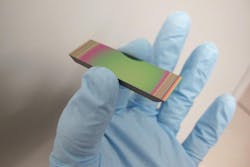Chips Steer Lasers Nonmechanically
Engineers at the U.S. Naval Research Laboratory have recently built and tested a new nonmechanical chip-based beam steering technology that gives designers an alternative to costly, cumbersome, and often unreliable and inefficient mechanical gimbal-style laser scanners.
The chip, dubbed the steerable electro-evanescent optical refractor, or SEEOR, takes in laser light in the mid-wavelength infrared (MWIR) and steers it in two dimensions at the output without using any mechanical devices. It also has better steering and higher scan speeds than conventional methods.
“Given SEEOR’s small size, low weight, and power consumption, and continuous steering capability, it represents a promising path for MWIR beam-steering,” says Jesse Frantz, NRIL research physicist. “Mapping in the MWIR spectral range could be useful in several applications, such as chemical sensing and monitoring emissions from waste sites, refineries, and other industrial facilities.”
To date, beam steering has relied mainly on mechanical devices, such as gimbal-mounted mirrors or rotating Risley prisms. These are large, heavy, and power-hungry, with slow scan rates, high repair and replacement costs, and short lifetimes before mechanical failure. SEEORs could replace traditional beam steerers with much smaller, lighter, and faster devices that use miniscule amounts of electrical power and have long lifetimes because there are no moving parts. (Jason Myers/U.S. Naval Research Laboratory)
SEEOR is based on an optical waveguide, a structure that confines light in a set of layers less than a tenth the thickness of a human hair. The laser beam enters through one facet and moves into the waveguide’s core. Once inside, some of the light gets into the liquid crystal layer on top of the core. A voltage applied to the crystal layer through a series of patterned electrodes changes the refractive index (in effect, changing the speed of light within the material) in portions of the waveguide, making it act as a variable prism. Careful design of the waveguides and electrodes lets this refractive index change be translated to high-speed and continuous steering in two dimensions.
SEEORs were originally developed to manipulate shortwave infrared (SWIR) light, the same part of the spectrum used for telecommunications. They found a home in guidance systems for self-driving cars.
“Making a SEEOR that works in the MWIR was a major challenge,” Frantz says. “Most common optical materials do not transmit MWIR light or are incompatible with the waveguide architecture, so developing these devices required a tour de force of materials engineering.”
NRL researchers had to come up with new waveguide structures and liquid crystals that are transparent in the MWIR, as well as new ways to pattern these materials and new ways to alignment the liquid crystals so they did not absorb too much light. The resulting SEEORs were able to steer MWIR light through an angular range of 14 × 0.6 deg. The researchers are now working on increasing this angular range and extending the portion of the optical spectrum where SEEORs work.


